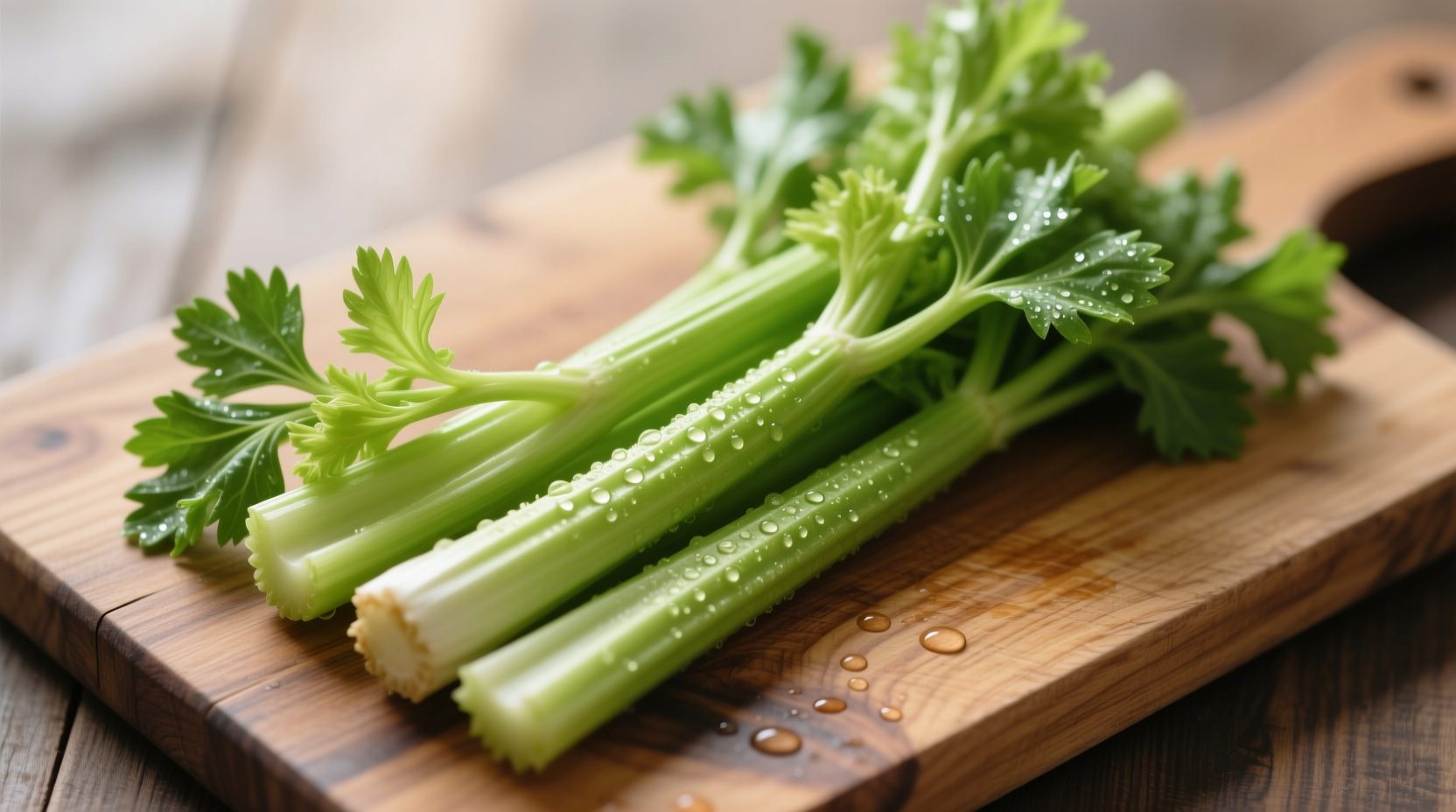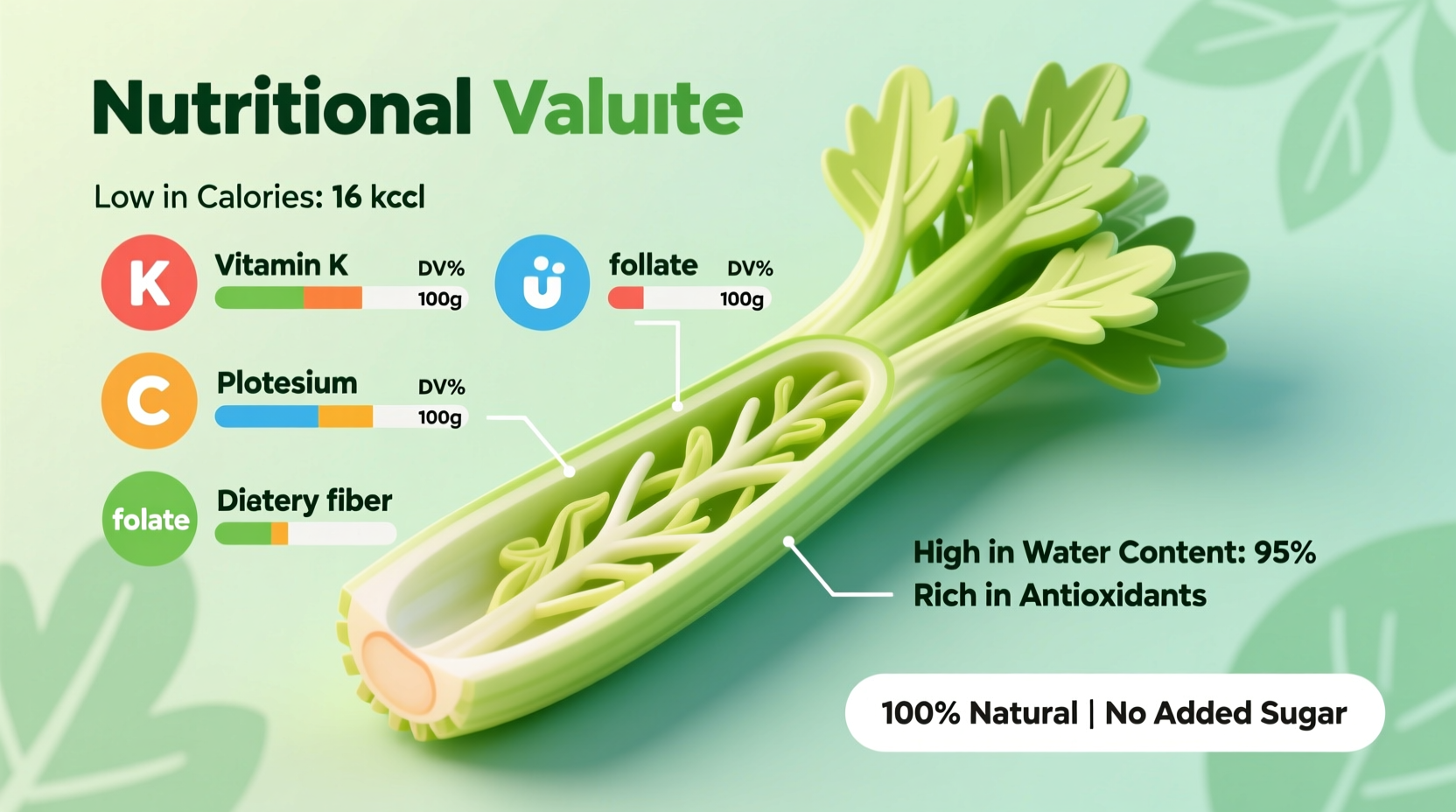One cup (101g) of chopped celery contains just 16 calories, provides 14% of your daily vitamin K needs, and delivers valuable amounts of vitamin A, potassium, and dietary fiber. This crunchy vegetable offers hydration benefits with 95% water content while contributing antioxidants and anti-inflammatory compounds that support heart health and digestion.
Why Celery Deserves a Place in Your Daily Diet
When you're searching for "celery nutritional value," you're likely looking for more than just basic numbers. You want to know how this common vegetable actually benefits your health and whether it's worth incorporating into your meals. The truth is, celery's nutritional profile punches far above its weight class despite its reputation as a "negative calorie" food.
Celery's Complete Nutritional Profile
Understanding celery's nutritional composition requires looking beyond just calorie counts. This versatile vegetable offers a spectrum of essential nutrients that contribute to overall wellness. Let's examine what makes celery nutritionally valuable.
| Nutrient | Amount per 1 Cup (101g) | % Daily Value |
|---|---|---|
| Calories | 16 | 1% |
| Total Fat | 0.1g | 0% |
| Sodium | 80mg | 3% |
| Total Carbohydrate | 3g | 1% |
| Dietary Fiber | 1.6g | 6% |
| Sugars | 1.3g | - |
| Protein | 0.7g | 1% |
| Vitamin A | 453 IU | 9% |
| Vitamin C | 3.1mg | 5% |
| Vitamin K | 32.2mcg | 27% |
| Potassium | 260mg | 7% |
| Folate | 36.4mcg | 9% |
Data source: USDA FoodData Central
Health Benefits Backed by Science
Celery isn't just a low-calorie snack—it contains powerful plant compounds that deliver measurable health benefits. Research from the National Institutes of Health shows that celery's apigenin and luteolin flavonoids have significant anti-inflammatory properties.

Heart Health Support
The potassium content in celery (260mg per cup) helps regulate blood pressure by counteracting sodium's effects. A study published in Hypertension found that increased potassium intake correlates with reduced cardiovascular disease risk.
Digestive Benefits
With 1.6g of dietary fiber per cup and high water content, celery promotes healthy digestion. The insoluble fiber adds bulk to stool while soluble fiber feeds beneficial gut bacteria. Unlike some high-fiber foods, celery rarely causes bloating or gas when consumed in moderate amounts.
Hydration and Electrolyte Balance
At 95% water content, celery contributes significantly to daily hydration needs. Its natural sodium-potassium balance makes it particularly effective for rehydration after exercise, outperforming many sports drinks for natural electrolyte replacement.
Maximizing Celery's Nutritional Value
How you prepare celery dramatically affects its nutritional benefits. Research from the Journal of Food Science and Technology reveals that:
- Consuming celery with its leaves provides 3x more vitamin K and calcium than stalks alone
- Light cooking (steaming for 5 minutes) increases antioxidant availability by 25%
- Pairing celery with healthy fats (like olive oil) enhances absorption of fat-soluble vitamins
- Storing celery in water preserves crunch and nutrient content longer than dry storage
Celery Compared to Other Vegetables
While celery isn't the most nutrient-dense vegetable, it offers unique advantages in specific contexts:
| Nutrient | Celery | Cucumber | Carrot |
|---|---|---|---|
| Calories (per cup) | 16 | 16 | 52 |
| Vitamin K (%DV) | 27% | 10% | 16% |
| Potassium (mg) | 260 | 152 | 410 |
| Dietary Fiber (g) | 1.6 | 0.5 | 3.6 |
| Unique Compounds | Apigenin, Luteolin | Cucurbitacins | Beta-carotene |
This comparison shows celery's advantage in vitamin K content and unique phytonutrients, though carrots provide more fiber and beta-carotene. Cucumber shares similar hydration properties but lacks celery's distinctive antioxidant profile.
Practical Ways to Incorporate Celery Daily
Forget the tired celery-and-peanut-butter snack—modern nutrition science reveals more effective ways to leverage celery's benefits:
Morning Hydration Boost
Start your day with celery juice (made from whole stalks including leaves) for maximum nutrient extraction. Unlike store-bought versions, homemade celery juice retains all fiber and enzymes. Add lemon for enhanced vitamin C absorption.
Cooking Applications
Use celery as a flavor base in soups and stews (mirepoix), but add it during the last 10 minutes of cooking to preserve nutrients. The leaves make an excellent garnish for fish dishes, providing both flavor and nutritional benefits.
Snacking Strategies
Pair celery sticks with hummus or Greek yogurt dip to increase protein content and fat-soluble vitamin absorption. For a metabolic boost, try celery with almond butter and a sprinkle of chia seeds.
Important Considerations and Limitations
While celery offers numerous benefits, it's essential to understand its limitations:
- Celery lacks significant protein and healthy fats, so pair it with complementary foods
- People with celery allergies (common in pollen-food syndrome) should avoid raw celery
- The sodium content (80mg per cup) matters for those on strict low-sodium diets
- Celery's oxalate content may be problematic for individuals prone to kidney stones
According to the FDA Food Allergen Education, celery ranks among the top 10 food allergens in Europe, though it's less common in the United States.
Conclusion: Celery's Role in Balanced Nutrition
Celery's nutritional value extends far beyond its low-calorie reputation. When incorporated thoughtfully into your diet, it provides valuable hydration, specific vitamins and minerals, and unique plant compounds that support multiple aspects of health. The key is understanding how to maximize its benefits through proper preparation and strategic pairing with other nutrient-dense foods.











 浙公网安备
33010002000092号
浙公网安备
33010002000092号 浙B2-20120091-4
浙B2-20120091-4